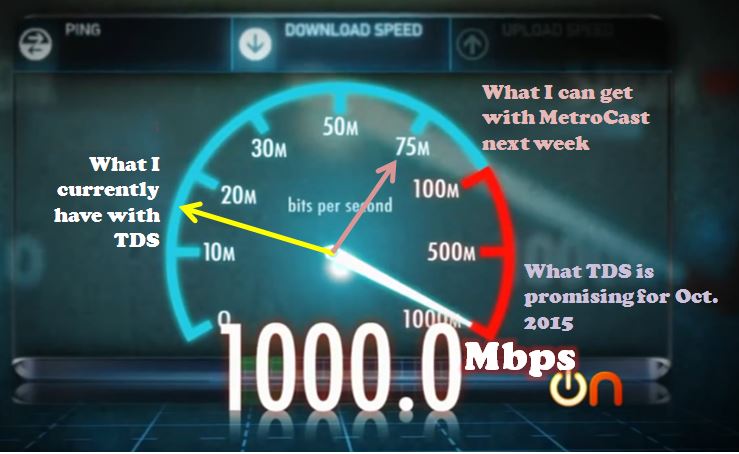In computing, bandwidth is the bit-rate of available or consumed information capacity expressed typically in metric multiples of bits per second. Variously, bandwidth may be characterized as network bandwidth, data bandwidth, or digital bandwidth.
This definition of bandwidth is in contrast to the field of signal processing, wireless communications, modem data transmission, digital communications, and electronics, in which bandwidth is used to refer to analog signal bandwidth measured in hertz, meaning the frequency range between lowest and highest attainable frequency while meeting a well-defined impairment level in signal power. The connection to the computing term is that, according to Hartley's law, the digital data rate limit, or channel capacity, of a physical communication link is proportional to its bandwidth in hertz.
Network bandwidth capacity
The term Bandwidth sometimes defines the net bit rate (aka. peak bit rate, information rate, or physical layer useful bit rate), channel capacity, or the maximum throughput of a logical or physical communication path in a digital communication system. For example, bandwidth tests measure the maximum throughput of a computer network. The reason for this usage is that according to Hartley's law, the maximum data rate of a physical communication link is proportional to its bandwidth in hertz, which is sometimes called frequency bandwidth, spectral bandwidth, RF bandwidth, signal bandwidth or analog bandwidth
Network bandwidth consumption
Bandwidth in bit/s may also refer to consumed bandwidth, corresponding to achieved throughput or goodput, i.e., the average rate of successful data transfer through a communication path. This sense applies to concepts and technologies such as bandwidth shaping, bandwidth management, bandwidth throttling, bandwidth cap, bandwidth allocation (for example bandwidth allocation protocol and dynamic bandwidth allocation), etc. A bit stream's bandwidth is proportional to the average consumed signal bandwidth in Hertz (the average spectral bandwidth of the analog signal representing the bit stream) during a studied time interval.
Channel bandwidth may be confused with useful data throughput (or goodput). For example, a channel with x bps may not necessarily transmit data at x rate, since protocols, encryption, and other factors can add appreciable overhead. For instance, a lot of internet traffic uses the transmission control protocol (TCP), which requires a three-way handshake for each transaction. Although in many modern implementations the protocol is efficient, it does add significant overhead compared to simpler protocols. Also, data packets may be lost, which further reduces the useful data throughput. In general, for any effective digital communication, a framing protocol is needed; overhead and effective throughput depends on implementation. Useful throughput is less than or equal to the actual channel capacity plus implementation overhead.
Asymptotic bandwidth
The asymptotic bandwidth (formally asymptotic throughput) for a network is the measure of maximum throughput for a greedy source, for example when the message size (the number of packets per second from a source) approaches infinity.
Asymptotic bandwidths are usually estimated by sending a number of very large messages through the network, measuring the end-to-end throughput. As other bandwidths, the asymptotic bandwidth is measured in multiples of bits per seconds
Multimedia bandwidth
Digital bandwidth may also refer to: multimedia bit rate or average bitrate after multimedia data compression (source coding), defined as the total amount of data divided by the playback time.
Bandwidth in web hosting
In Web hosting service, the term bandwidth is often incorrectly used to describe the amount of data transferred to or from the website or server within a prescribed period of time, for example bandwidth consumption accumulated over a month measured in gigabytes per month. The more accurate phrase used for this meaning of a maximum amount of data transfer each month or given period is monthly data transfer.
A similar situation can occur for end user ISPs as well, especially where network capacity is limited (for example in areas with under developed internet connectivity and on wireless networks).
Internet connection bandwidth
This table shows the maximum bandwidth (the physical layer net bitrate) of common Internet access technologies. For more detailed lists see
- list of device bandwidths
- bit rate progress trends
- list of multimedia bit rates.
| 56 kbit/s | Modem / Dialup |
| 1.5 Mbit/s | ADSL Lite |
| 1.544 Mbit/s | T1/DS1 |
| 2.048 Mbit/s | E1 / E-carrier |
| 8 Mbit/s | ADSL1 |
| 10 Mbit/s | Ethernet |
| 11 Mbit/s | Wireless 802.11b |
| 24 Mbit/s | ADSL2+ |
| 44.736 Mbit/s | T3/DS3 |
| 54 Mbit/s | Wireless 802.11g |
| 100 Mbit/s | Fast Ethernet |
| 155 Mbit/s | OC3 |
| 600 Mbit/s | Wireless 802.11n |
| 622 Mbit/s | OC12 |
| 1 Gbit/s | Gigabit Ethernet |
| 2.5 Gbit/s | OC48 |
| 5 Gbit/s | USB 3.0 |
| 9.6 Gbit/s | OC192 |
| 10 Gbit/s | 10 Gigabit Ethernet, USB 3.1 |
| 100 Gbit/s | 100 Gigabit Ethernet |

